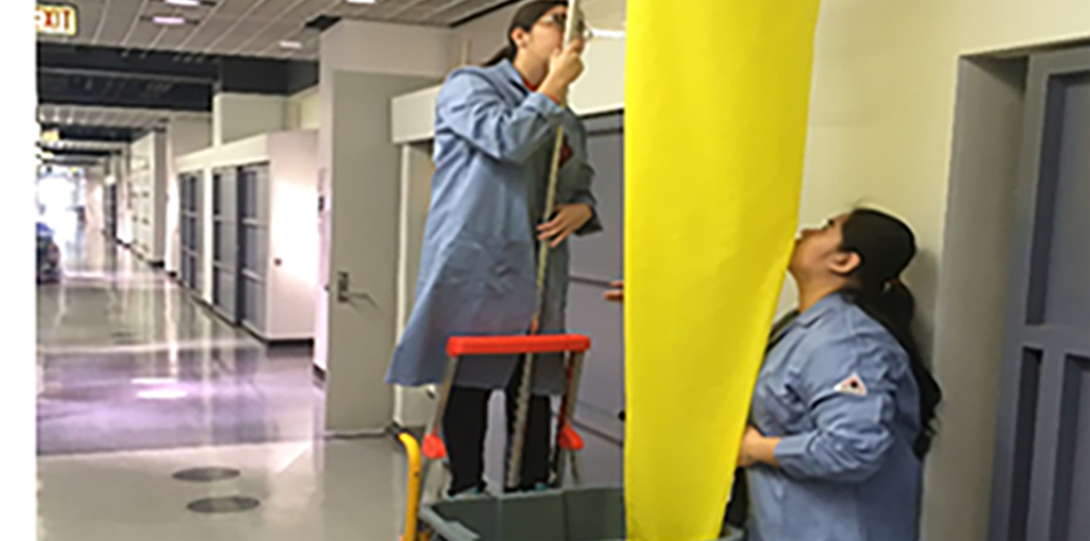Emergency Shower and Eyewash Safety Program
Emergency Shower and Eyewash Safety Program Heading link
Introduction
The purpose of the UIC Emergency Shower and Eyewash Safety Program is to ensure that emergency showers and eyewash units are working properly and supplying sufficient clean water to flush out or wash off any hazardous contaminants that personnel may encounter while performing their jobs.
The Occupational Safety and Health Administration (OSHA), requires the access to suitable units for quick drenching or flushing of the eyes and body within the work area for immediate emergency use where any person is at risk of being exposed to hazardous materials (29 CFR 1910.151 (c)). The Environmental Health and Safety Office (EHSO) conducts routine laboratory safety audits including annual inspections of eyewash stations and safety showers to ensure optimal operations in emergency situations and in compliance with OSHA. The following is an abridged description of the inspection, testing and maintenance of emergency showers and eyewash units. The complete Emergency Shower and Eyewash Safety Program Manual can be accessed from this link:
Where should a unit be located?
- Within work areas where employees may be at risk of exposure to injurious corrosive materials, requiring “suitable facilities” for immediate emergency use in drenching or flushing of the eyes and body [29 CFR 1910.151(c)].
- In a laboratory and work areas which manipulate human blood or body fluid and other potentially infectious materials, a hand washing and an eye wash station shall be readily available for use in the event of an emergency [29 CFR 1910.1030 (e)(3)9i), (e)(4)(iii)]
- In work areas where employees may be at risk of skin exposure to solutions containing 1 percent or greater formaldehyde and/or in work areas where employees may become splashed in the eyes with solutions containing 0.1 percent or greater formaldehyde [29 CFR 1910.1048 (i)(2), (i)(3)].
- An emergency shower and eye-wash station is required in work areas where certain hazardous materials are handled such as pesticide storage and mixing facilities, battery repair areas, etc. [29 CFR 1910. 151 (c)].
Important requirements for Eyewash and Safety Showers
- Be accessible within 10 seconds
- Be located on the same level as the hazard
- Be free of obstruction
- Be identified with highly visible signage
- Go from “Off” to “On” in one second or less when operated
- Deliver tepid flushing fluid 60-100O F (16-38OC), for a full 15 minutes.
Responsibilities
EHSO
- Conducts annual and periodic audits of emergency showers and eyewash stations in research labs, Hospital and Clinics according to the ANSI Z358.1 Standard guideline.
- Provide consultations to FM and campus units on purchase and installation of Emergency safety equipment and accessories.
Principal Investigators and Departmental Units
- Weekly flushing of eyewash units and keeping flushing logs up to date and accessible for auditing.
- Provide students and employees with training on location and how to use emergency showers and eyewash stations.
- Notify EHSO (biosafety@uic.edu) of eyewashes or showers that have been repaired or newly-installed for re-inspection.
- Schedule and reschedule appointments with EHSO (biosafety@uic.edu) for the annual emergency shower and eyewash audit.
Installation
- Facilities Management (FM) and Contractors shall notify EHSO (biosafety@uic.edu) of plans to install a new eyewash unit or safety shower.
- Contractors and will assemble and install all units per manufacturer’s instructions. Units shall also meet the requirements of the American National Standard Institute (ANSI) Emergency Eyewash and Shower Equipment Standard Z358.1-2014.
- Newly installed emergency eyewash and safety shower shall be equipped with a mixing valve, which allows a supply of tepid water.
Quick Links
UIC Emergency Shower and Eyewash Safety Program Manual
Recommended Signs and Specifications for Emergency Equipment


